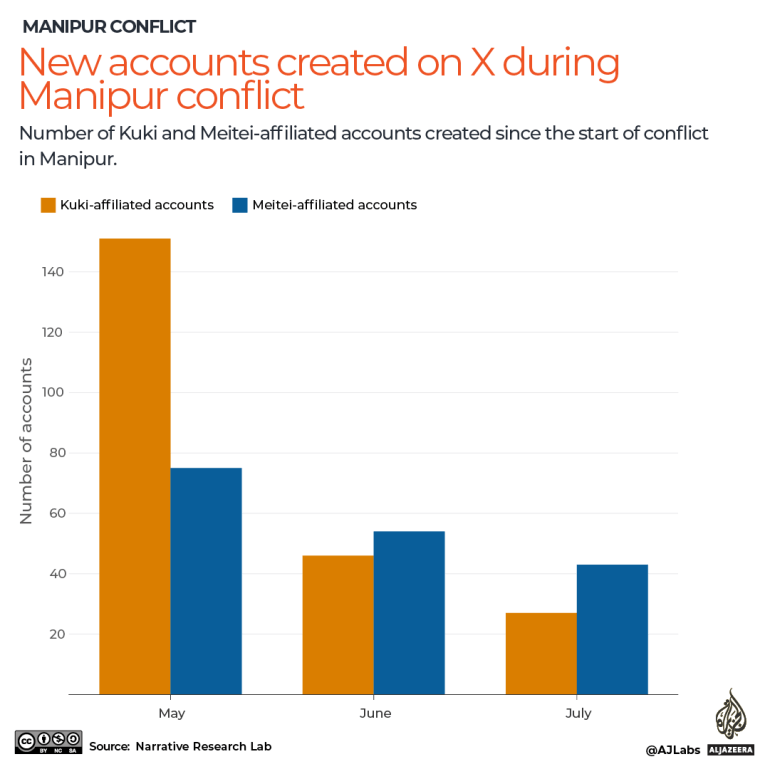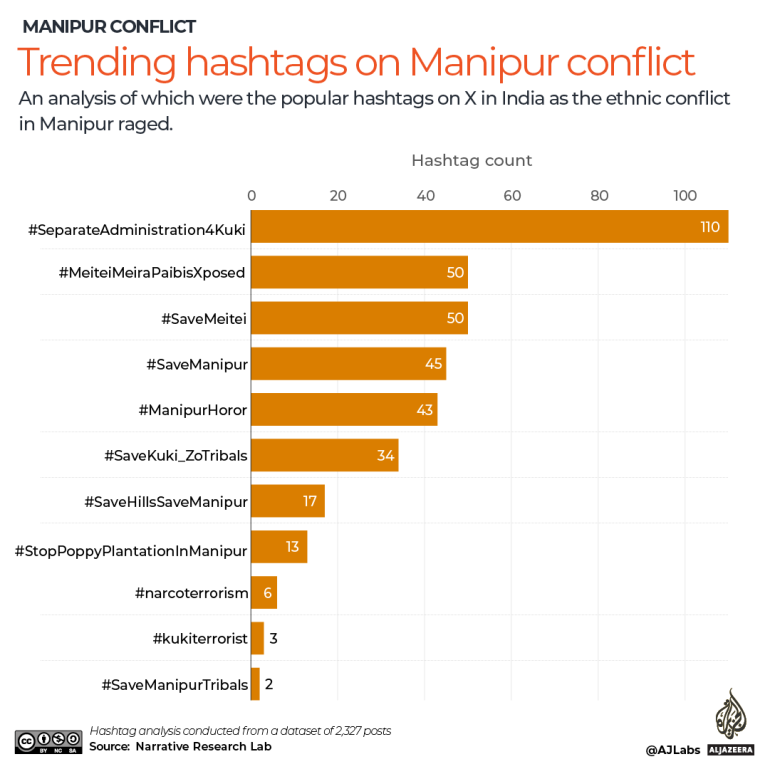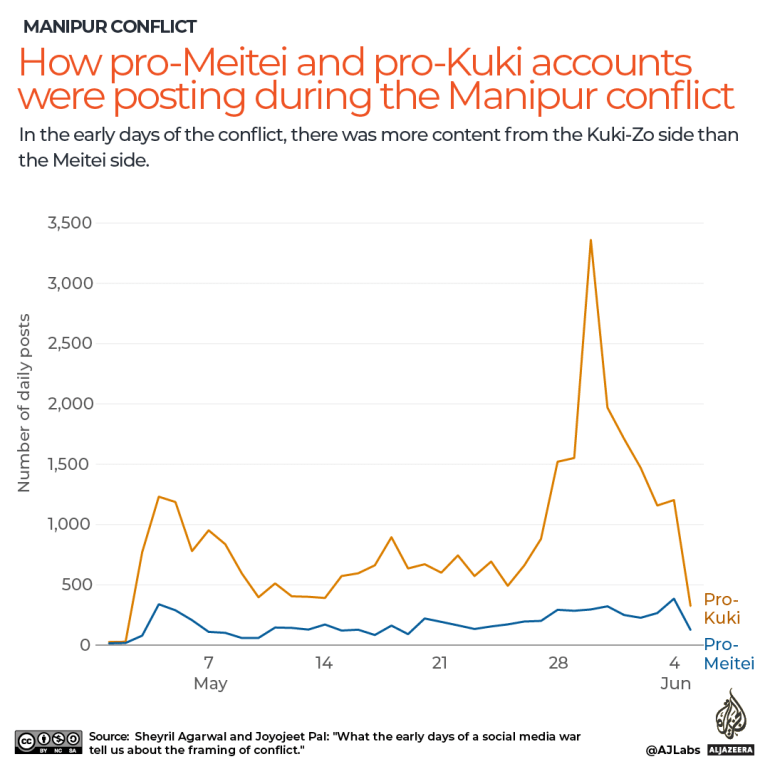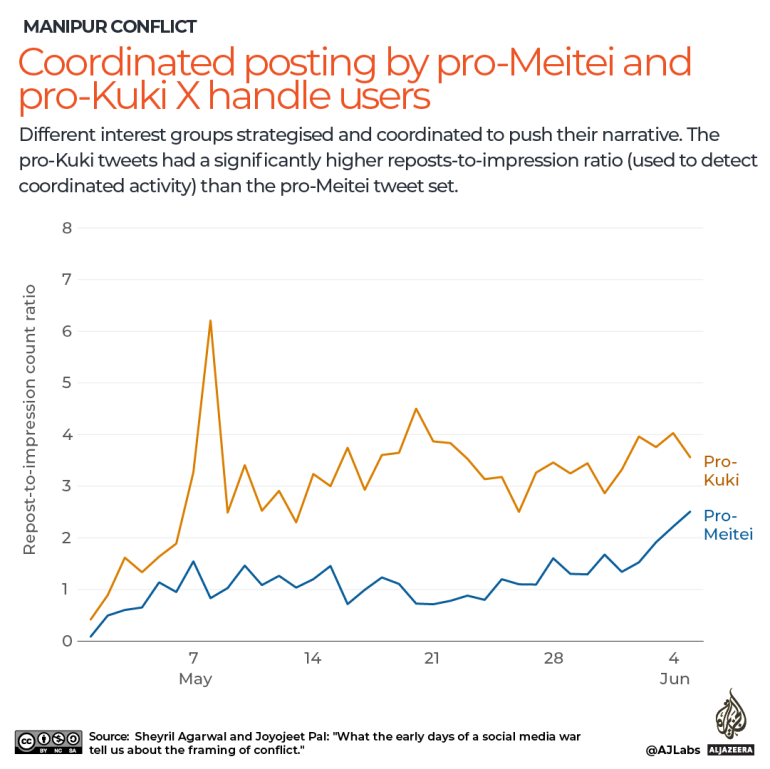In India’s strife-torn Manipur, narrative battle is fought on social media
Social media warriors have sprung up to share their community’s views and put down the others’ in this ethnic conflict.
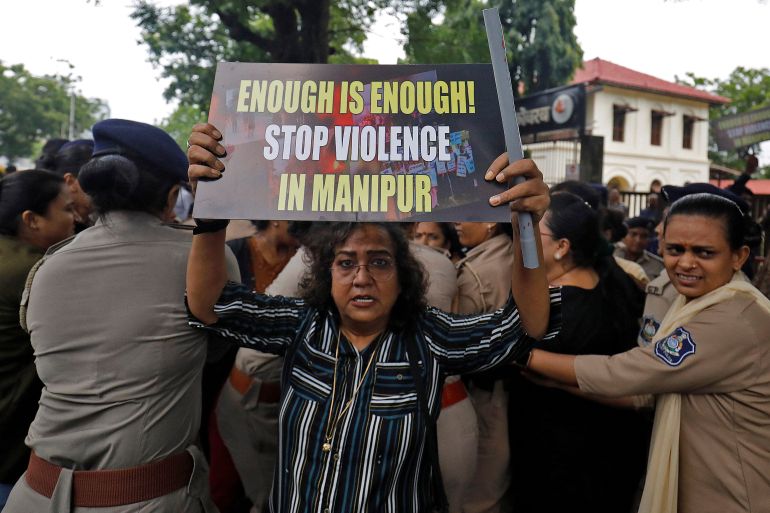
Churachandpur, India – In early June, two men sat hunched over, working on laptops inside a partially constructed building in the Churachandpur district of northeastern India’s Manipur state.
A fire had been raging across Manipur since May 3. Several parts of the state, including Churachandpur, were engulfed in an ethnic conflict between the Kuki-Zo and the Meitei people, who are among the largest ethnic groups in the state, which borders Myanmar.
Keep reading
list of 4 itemsUS TikTok’s future in jeopardy as Biden signs ban bill: What’s next?
US Senate passes bill to force sale of TikTok, sending it to Biden
‘Arrogant billionaire’: Australia, Musk in war of words over censorship
The Kuki-Zo people are a majority in Churachandpur and some other hilly areas while the Meitei dominate the state capital, Imphal, and a few adjoining towns and rural areas.
On May 4, the state government blocked access to the internet across all of Manipur.
Yet in June, on the 37th day of the violence when a leader of a Kuki-Zo civil society organisation led me into the building in a residential area of Churachandpur, to my surprise, the internet was up and running on his phone and that of the other Kuki men in the room.
The leader told me, “We pay hackers up to 1 lakh rupees [$1,200] to 1.5 lakh rupees [$1,800] for the internet. We were without internet for 15 to 20 days before these connections were set up.”
The internet had been restricted by the state to some phone lines for the use of the state machinery. The hackers helped the group get online by connecting to these lines.
For what?
“It was important to do this for students who had to fill [online] forms for exams, etc,” the leader said.
But there were other, more important, reasons. “Before we got hackers [and access to the internet], we had given access to our social media accounts to people outside the state … Social media has become important to tell people what is happening here,” the leader said.
Violence was happening on the ground but hundreds of people like the Kuki-Zo leader and his associates as well as people from the Meitei community took on the task of running the message machine, providing powerful ammunition in the battle to shape narratives on social media.
An analysis of social media over two months by The Reporters’ Collective revealed a significant surge in new accounts on X, formerly known as Twitter, voicing views on their respective sides and a proliferation of narratives about the conflict via Instagram and Facebook posts.
Social media posts from handles claiming to be affiliated with the Kuki or Meitei communities flowed freely, brimming with information, disinformation, hate, claims of victimhood and requests for solidarity. Reportage and opinions that did not square with theirs were trolled, and journalists were grouped into pro- and anti-camps.
As of mid-September, 175 people had died and 1,118 injured as per the latest data available.
Manipur has seen worse ethnic clashes. From 1992 to 1997, fighting between the Kuki and Naga communities reportedly caused greater loss of life, damage and destruction.
But what sets the recent violence apart is that it is probably the first armed conflict in India being fought hard on social media, as well. The narratives spread from each community have closely followed the events on the ground and sometimes provided the first evidence of incidents that later made it into the news.
In at least two instances of violence – the first of two Kuki-Zo women being paraded naked, a video of which went viral, and the second of two Meitei students being killed, images of which also went viral – added to the vitriol being spread over social media. In both cases, the situation was aggravated with protests being held in the state.
Disinformation campaigns by these social media warriors have also reinforced the hostilities.
For instance, in the early part of the conflict, a picture of a woman’s body wrapped in plastic was shared widely with a claim that it was the body of a Meitei woman who had been sexually assaulted. Fact-checking websites like BOOM later reported that the body was that of a woman killed by her parents in Delhi.
A month later, another video claimed that a Christian Kuki woman was assaulted by armed civilians. BOOM later found the video had originated in Myanmar.
Manufactured narratives
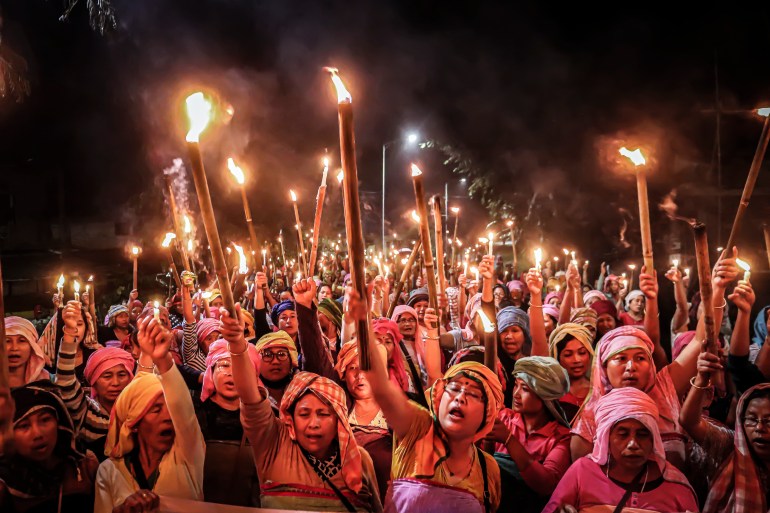
Two separate studies by the Delhi-based Narrative Research Lab, as well as Joyojeet Pal of the University of Michigan and independent researcher Sheyril Agarwal, revealed patterns of how the narratives were being manufactured and organically built on X. They shared their findings with The Reporters’ Collective.
Most media reports suggested that the conflict began with a sudden and unexpected outbreak of violence on May 3. Similar to the situation on the ground, social media users were quick to respond, the research suggested.
More than 100 handles were created in the first few days of the violence.
Violence broke out in Kuki-dominated Churachandpur on May 3. This was followed by days of widespread violence against the Kuki community in the capital, leading to an exodus of Kuki people from Imphal and of the Meitei from Churachandpur and other Kuki-dominated areas as they sought refuge in other parts of the state. The violence soon spread to the rural areas where the valley meets the hills, and Kuki, Meitei and other communities exist cheek by jowl.
While the number of people dying has eased up in the last few days, the bunkers are still very much in place and civilians from both sides continue to be trained on how to use arms.
Pal and Agarwal’s research showed that initially, handles sympathising with or affiliated with the Kuki community mushroomed and tweeted actively with well-coordinated messaging.
Meitei-associated handles got into the narrative game later but quickly came up to speed and were actively tweeting, including with aggressive attacks on opposing views and disinformation campaigns.
The Kuki-Zo leader who accessed the internet sitting in the partially constructed building gave me a glimpse of how the civil war in Manipur motivated people and the leadership of the two communities to tell the world “their truth” as they saw it.
The new warriors
The battles are largely being fought on X.
Siam Phaipi, a 33-year-old lawyer from the Kuki-Zo community, is among those who started tweeting after the conflict began.
He told me, “I opened this account because of people’s suggestion that it is easier to spread awareness on Twitter than on FB [Facebook] or [other] social media, especially because all politicians use this Twitter platform more than other social media pages/profiles.”
From May, hundreds of handles like Phaipi’s began tweeting on behalf of one or the other community on X.
The Reporters’ Collective identified nine prominent handles each posting in favour of Kuki and Meitei narratives and shared them with the Narrative Research Lab in the last week of July.
Using these 18 handles, the lab mapped 2,722 other handles – 875 of the handles were followers of these 18 handles and 1,847 of the handles were followers of the 875 handles.
The lab scanned through their meta-data – information that describes and helps make sense of data – for trends.
Of these 2,722 handles, 455 were clearly identified as Kuki-affiliated and 487 as Meitei-affiliated.
More than half of the Kuki-affiliated handles (51 percent) were created on or after May 3. In the case of Meitei-affiliated handles, 40 percent were created on or after May 3.
The rest were in an ambiguous category: 1,733 were classified as “others” whose affiliations could not be discerned manually or through algorithmic methods; 47 handles were protected, no longer existed, belonged to officials (including police and media) or had been suspended or withheld.
The platform does not provide accurate data on where the tweets originate, so it is possible that the Kuki leader and his friends were exceptions who had hacked into the internet while in Churchandpur.
There are also allegations that despite a ban on the internet, a few people in Imphal had internet access because they were close to the government.
People from Manipur could also have been tweeting remotely because many people from the two communities study and work in the rest of India and abroad.
Opposing handles
The Indigenous Tribal Leaders’ Forum (ITLF), a key political association of Kuki leaders that has accused Manipur’s chief minister, the state police and sections of Meitei people, including armed militia, of carrying out a genocide against their community, has had a strong presence on X since the start of the conflict.
At the time, the Meitei community did not have such a singular voice reflecting political and civil society leadership on social media.
The ITLF ran an active WhatsApp group from June 4 to share posts and updates on the hardships faced by the Kuki-Zo community, putting them in front of many journalists from across India.
The Reporters’ Collective was able to find evidence of at least one group, COCOMI Media, formed by political actors from the Meitei community, which became active in July.
It was purportedly started by leaders of the Coordinating Committee on Manipur Integrity (COCOMI), a conglomerate of Meitei civil society organisations.
The Narrative Research Lab mapped the frequent use of standard hashtags by many handles. The hashtag #SeparateAdministration4Kuki highlights the demand by Kuki-Zo groups for a separate state, which intensified since the conflict started.
In return, the Meitei-affiliated handles accused the Kuki community of “narcoterrorism” and of being undocumented migrants on the back of a history of a narcotics trade and the inflow of people from Kuki-Chin-Zo communities from Myanmar.
Since the start of the conflict, social media warriors of each community kept asserting that the other community was not nationalistic or Indian enough.
Patterns of mobilisation
University of Michigan’s Pal and independent researcher Agarwal noted that the first bump in social media activity was seen around April 28, fired up by the burning of a gym in Churachandpur that the state’s chief minister was due to inaugurate.
The next spurt happened on May 3 following the violence triggered after several tribal groups held a protest against a demand by Meitei groups for scheduled tribe status, which would accord them privileges.
“First, we see that the shutdown of internet services meant that there was very little direct access to the voice of people in Manipur, and the engagement was limited to those who have families in Manipur but are currently living outside the state,” the two researchers said.
As the graph highlights, the pro-Kuki-Zo community was quicker to organise.
“We also see evidence of better collective action on both sides in terms of when highly engaged accounts were set up,” the researchers noted in their analysis titled ‘What the early days of a social media war tell us about the framing of conflict’ that was shared with The Reporters’ Collective.
For instance, they said, 86 new accounts with high activity from the pro-Kuki-Zo side were set up in the first week of May. Pro-Meitei content saw 24 new accounts.
To study the patterns and differences between how members and backers of each community have tweeted about the ethnic riots, they also looked at a set of highly engaged X users: The pro-Meitei set contained 77 accounts with 6,339 original tweets and 7,837 retweets whereas the pro-Kuki set had 308 accounts, 31,462 tweets and 94,909 retweets.
“Pro-Kuki-Zo make more callouts to media accounts as compared with Pro-Meitei users. Two things stand out – Kuki calling out to the UN and other human rights organisations juxtaposed with Meitei calling out the Spearcorps account [a formation of the Indian army],” the researchers wrote in their analysis.
This played into the stance of the two communities – the Kukis said the rights of the Indigenous people were being impinged on by the Meiteis, hence the callouts to the United Nations seeking its intervention.
Similarly, the Meiteis accused the Assam Rifles, a paramilitary force under the Indian army, of being in favour of the Kukis and have tweeted about it.
The researchers tied that to how the groups mentioned political parties.
In the case of the Meitei, tweets skewed towards the governing Bharatiya Janata Party (BJP) because Chief Minister Biren Singh, a BJP member, was in the first month of the conflict seen as someone they could rely on, “whereas Kuki-affiliated accounts have a more even distribution between major political parties”, they noted.
The researchers analysed 2,765,151 tweets relating to Manipur from May 1 to June 5 and found evidence of coordinated activity. Only 11.6 percent, or 322,094 tweets, out of that total were original posts.
“We observe a considerable amount of copy-paste in our dataset with 788 tweets copy-pasted more than five times without any modification from the source text,” the researchers said.
The researchers also found that the Kuki-affiliated accounts had a higher retweet-to-impression ratio. In other words, there was more concerted activity on X by the Kuki-affiliated handles than the Meitei-affiliated ones.
“If you narrow it down by scenario and look at this kind of narrative exchange and narrative battle, you usually have a mix of genuine users with accounts and some amount that is synthetic,” meaning bots, said Prateek Waghre, policy director at the Internet Freedom Foundation, a Delhi-based non-governmental organisation that advocates for digital rights.
Researcher and technologist Rohini Lakshane listed reasons why so many accounts may have been created since the conflict started: “To give out information of the local goings-on firsthand – information of the sort that would otherwise not make its way to the intended audience, at least not quickly,” she said.
“It could be for mobilisation, peaceful or otherwise, and lastly to create a narrative. The intent behind the narrative could range from voicing their own story or opinion to intentionally spreading misinformation.”
The research shows “a pattern of Intelligent actors affiliated with the respective communities trying to define the moral contours of the conflict for the rest,” said Sarabjot, a co-founder of the Narrative Research Lab. Such “concerted efforts” to push narratives during the conflict, “can have a long-term impact, engender hate and animosity and diminish the space for peacebuilding,” he added.
The two studies used different methods to collect data, their periods of observation differ and the method of analysis also differs, so the findings of the two cannot be conflated.
A manual review of the data throws up several examples of dubious handles used to push the narrative of one or the other side.
Take the example of this account of user Yamkhongam Touthang (@YTouthang). Before August, it would repost cryptocurrency-related advertisements. After August 8, it began reposting comments about the conflict, favouring the Kuki community.
While sections of both communities, their political leaders and armed groups fought it out on the ground, the war on social media became sophisticated. Well-produced videos and drone footage made it onto social media, the latter more often on Instagram
Superspreaders
There have been at least two instances of superspreader events on social media during the conflict.
On September 25, two images went viral over several social media platforms in which 20-year-old Phijam Hemanjit and 17-year-old Hijam Linthoingambi, residents of Imphal who had gone missing, were depicted as dead.
In the first image, Linthoingambi and Hemanjit are seen sitting next to each other. The subsequent image shows them slumped on the ground, presumably dead, with Hemanjit’s head missing.
On X, Meiteis wrote scathing tweets against the Kuki-Zo community. Meanwhile, Kukis criticised the government’s decision to put the Central Bureau of Investigation in charge of the case.
The Kuki handles contended that such a “quick” response had been lacking in cases in which people from the Kuki-Zo community were allegedly killed. Some also questioned if there was sufficient evidence to say whether the two had been killed at all.
Soon after the images emerged in late September, protests erupted in Imphal, compelling the state government to snap shut the internet that had been restored just days before following a five-month-long suspension.
Earlier in July, a video of two Kuki-Zo women being paraded naked led to a similar response from the Kuki community. Huge rallies were held by Kuki women in Kangpokpi, Churachandpur and Mizoram. For the first time since the conflict started, Prime Minister Narendra Modi commented on the situation in Manipur condemning the incident of sexual violence and said the incident “has made 140 crore Indians hang their heads in shame”.
At the time, Kuki handles on X renewed calls for a separate administration and their posts were reposted hundreds of times.
‘If you don’t take off your clothes,we will kill you’:Kuki women paraded in #Manipur
It’s impossible for #Kuki_Zo to live together with these barbaric #Meiteis when chopping,raping,looting,burning is what normalcy seems for these desperate animals.
SEPARATION ONLY SOLUTION!✊🏻 pic.twitter.com/TPCo8DvYz9
— Kimmi Khongsai (@KimmiKhs) July 20, 2023
“Countering” narratives
The users behind the most popular Kuki and Meitei handles say their main motivation is to counter the narratives propagated by the other side.
I reached out to three handles that are sympathetic to the Kuki community’s narrative and claim to be Kuki as well as five handles from the Meitei, to understand their motivations.
People behind two of the Kuki-affiliated handles and two of the Meitei-affiliated handles spoke with me. Some preferred to remain anonymous. Others either had disclosed their identity in public or agreed to do so with me.
Each one who spoke pointed to the need for their community’s voice to be heard better. It was not possible for Al Jazeera to verify their stories.
ManipurTalks, which is now suspended, spoke to me in August on Discord, an instant messaging application, without disclosing his identity. He claimed to be living in Imphal.
“My account has been active since 2010, I’ve been doing news updates and what not, including satire,” he said.
Once the conflict started, he began increasingly tweeting about it, he said.
“In the beginning, I was accusing government officials for not controlling the conflict … I was angry at the government because they seemed to have had all the intelligence but had still not done anything,” he said.
Expectedly, he blamed the Kuki-affiliated handles for propaganda.
“I saw a lot of propagandist spin on the narrative. I asked my Kuki brothers and sisters to resolve this but later, I got to know that their intention wasn’t to curtail the conflict. Later, I realised they had been influenced by a separatist agenda. I saw them sharing one-sided propaganda. That’s when I decided to drop my guard and discuss Meitei’s side of the story, as well.”
“Even if one person sees it, that is good enough. I need to tell the story. Earlier, in the beginning of this conflict, there was a one-sided narrative. After seeing my tweets, they’re realising there is another side,” he said.
Until August 10, ManipurTalks had amassed more than 11,500 followers. ManipurTalks’s X account was withheld on 15 August “in response to a legal demand“.
According to X’s guidelines, “it means X was compelled to withhold the entire account specified (e.g., @username) in response to a valid legal demand, such as a court order”. The users usually are not told who asked for their account to be withheld.
Phaipi, from the Kuki community, has the same explanation. “Ninety-nine percent of all my tweets are about spreading awareness about what’s happening in Manipur and about the ethnic cleansing that has been going on against the Kuki-Zo community,” he said.
Since launching his account on X in May, Phaipi has amassed more than 9,200 followers.
These accounts were not just looking to win over the locals but the global community too.
“I’m trying to convey my views to each and everyone in India as well as all over the world … It [X] has a bigger outreach and circle as compared to insta [Instagram] and FB [Facebook],” Phaipi said.
Of the civil society and political outfits representing the two communities, the ITLF proved nimble on X. It launched an account in May 2023 when the conflict began and by June 18, had amassed more than 5,800 followers.
When its handle @ITLFMediaCell was withheld in June “in response to a legal demand”, it opened another, @ITLFMediaCell(A), raking up almost double the number of followers in a little more than three months.
Al Jazeera spoke about it with Ginza Vualzong, the organisation’s spokesperson. “We started the ITLF account after the conflict because our voices were not heard. The narrative was dominated by the Meitei media,” he said.
“There was no internet in Manipur. So I asked volunteers from outside the state to start the social media handles… We use Twitter [X] to put up our voices and to counter-narrative by the other side,” he added.
In a similar vein, the Meitei Heritage Society, which describes itself as “a group of like-minded individuals working to present ethical news, fighting false narratives against Meiteis”, told me that the society came together in the wake of the violence in Manipur.
According to the member I spoke with, there was a “pre-planned false narrative that followed in sections of the national media and the social media to malign the image of Manipur and split the state.”
“The plan”, said the member, “was to weave a false story around minority tribals Christian Vs majority Meiteis to hide the real issues of the violence: illegal immigration from Myanmar, Illegal poppy cultivation & drug business and deforestation/encroachment into forest land.”
Handles from both communities had the same story to tell: Their respective communities had been wronged and the truth, as they believed it, had not reached the rest of India and the world.
At the time of writing this piece, the incidents of firing between the two sides has subsided for the time being, but the people continue patrolling the “borders” between the Kuki and Meitei areas. The internet ban has been lifted only partially with mobile internet still officially shut. That has not stopped the social media warriors of the two communities to continue to battle for the hearts and minds of the rest of the world.
Angana Chakrabarti is an associate member of The Reporters’ Collective.
